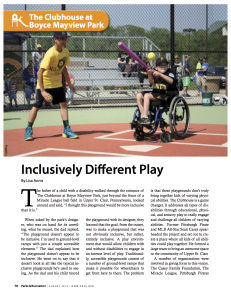by Lisa Annis
The father of a child with a disability walked through the entrance of The Clubhouse at Boyce Mayview Park, just beyond the fence of a Miracle League ball field in Upper St. Clair, Pennsylvania, looked around and said, “I thought this playground would be more inclusive than it is.”
When asked by the park’s designer, who was on hand for its unveiling, what he meant, the dad replied, “The playground doesn’t appear to be inclusive. I’m used to ground-level ramps with just a couple accessible elements.” The dad explained how the playground doesn’t appear to be inclusive. He went on to say that it doesn’t look at all like the typical inclusive playgrounds he’s used to seeing. As the dad and his child toured the playground with its designer, they learned that the goal from the outset was to make a playground that was not obviously inclusive, but rather, entirely inclusive. A play environment that would allow children with and without disabilities to engage in an intense level of play.
Traditionally, accessible playgrounds consist of a number of ground-level ramps that make it possible for wheelchairs to get from here to there. The problem with this design model is that these playgrounds don’t truly bring together kids of varying physical abilities. The Clubhouse is a game changer. It addresses all types of disabilities through educational, physical, and sensory play to really engage and challenge all children of varying abilities. Former Pittsburgh Pirate and MLB All-Star Sean Casey spearheaded the project and set out to create a place where all kids of all abilities could play together. He formed a large team to bring an awesome space to the community of Upper St. Clair.
A number of organizations were involved in giving form to this vision. The Casey Family Foundation, The Miracle League, Pittsburgh Pirates Charities, Let Kids Play and Cre8Play are just a few of a very large group of contributors. “There are always challenges when collaborating with this many contributors and sponsors. The biggest challenges are in the number of people who need to sign off on a lot of things,” commented Miracle League of South Hills Board Member Maura Rodgers.
The end result is a very meaningful play environment and a place that will be cherished for generations to come. The “glue” (think Crazy, not Elmer’s) in this case was the vision, the one thing that bonded all parties involved. The Clubhouse involved many passionate people who shared a laser-focused vision “to create a catalyst for learning through play and, more importantly, learning through play for all children, with and without special needs, where they would naturally play and grow together,” Rodgers says.
Inclusiveness is evident in the detail of every piece of equipment in the playground. It includes elements such as interactive games strategically positioned at varying heights, stainless steel slides to address cochlear implants and wheelchair accessibility at much higher elevations than the traditional inclusive playground. Other features included rail-guided play equipment for kids with walking impairments, a Cozy Cocoon by Playworld for children with autism and a Cre8Play baseball glove transfer-accessible climber.
The Clubhouse also includes elements that address children with vision impairments. Ben Brilmyer, M.S., CAPE, adapted physical education teacher for the Western Pennsylvania School for Blind Children, was blown away by the design. “Nowhere else have I seen such a seamless transition between adapted and more typical playground equipment,” he says. “Most other playgrounds offer an either/or option, while The Clubhouse provides an environment that encourages interaction between two very different populations of children.” Transitional color changes throughout the decking indicate changes in elevation (ramps and steps), handrail colors were selected to contrast with their backgrounds and 3D discovery finds are sculpted as positives into the play equipment. Many of the interactive games, such as baseball tic-tac-toe, have debossed characters. Visual impairment or not, these elements are fun and stimulating for all.
Going forward, when designing or retrofitting accessible playgrounds, the thinking needs to be inclusively different. If we’re not pushing the envelope, we’re falling flat for inclusive play. A child with a disability wants to play with his sister, brother and friend who is not disabled and vice versa. We owe it to our children to provide ways for those with varying ability levels to play together on the same playground and engage in vigorous, educational, stimulating and exciting play. At the end of the day, all they want is to play together and have fun. According to Casey, the playground is a home run: “We knew it would be something unique and something special. We feel it’s one-of-a-kind in the country. All the pieces were made for this place, and we feel like our kids deserve something like this.”
